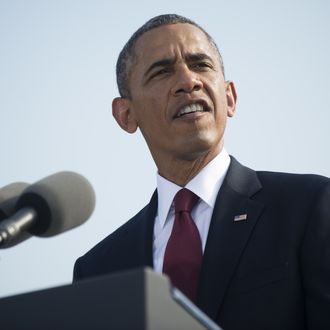
If you can think back two crises ago, you may recall that just last month, the United States appeared to be on the verge of bombing Syria. The front page of Wednesday’s New York Times has a lengthy account of how we came to that point after years of Obama administration indecisiveness on Syria. To be fair, nothing about the situation was clear cut, but President Obama’s calculus still seems off, starting with the assumption that like many other leaders in the Middle East, Assad would soon be ousted by his own people.
At first, it appeared that the situation might resolve itself. In summer of 2011, U.S. intelligence agencies told the White House and State Department that Assad probably wouldn’t hold on much longer. Obama declared that the “the time has come for President Assad to step aside,” though at that time the administration didn’t have a plan for how that might happen.
A year later, Assad was still in power. At the first high-level talks on potentially getting involved in Syria’s civil war, then-CIA Director David Petraeus laid out a plan to secretly arm and train groups of Syrian rebels in Jordan. Obama’s advisers were split on the issue, and remained so throughout many subsequent discussions. The president appeared hesitant to intervene in Syria, or make a call one way of the other, even as new intelligence in early 2013 suggested Assad was using chemical weapons, and the rebels were losing. Per the Times:
Even as the debate about arming the rebels took on a new urgency, Mr. Obama rarely voiced strong opinions during senior staff meetings. But current and former officials said his body language was telling: he often appeared impatient or disengaged while listening to the debate, sometimes scrolling through messages on his BlackBerry or slouching and chewing gum.
In private conversations with aides, Mr. Obama described Syria as one of those hellish problems every president faces, where the risks are endless and all the options are bad.
Eventually Obama went with a form of the Petraeus plan, authorizing the CIA to prepare for a “covert action” to arm and train the rebels in Jordan. He signed the secret order in April, but waited months before announcing his decision and asking Congress to finance it. The summer was spent convincing lawmakers to sign on, before the Aug. 21 chemical weapons attack forced Syria to the top of the agenda.
While Syria has greed to give up its chemical weapons, there’s little hope that the ongoing rebel training program will change the course of the war. One former senior White House official lamented, “We spent so much damn time navel gazing, and that’s the tragedy of it.” It’s a good thing Obama doesn’t care about style points.






























